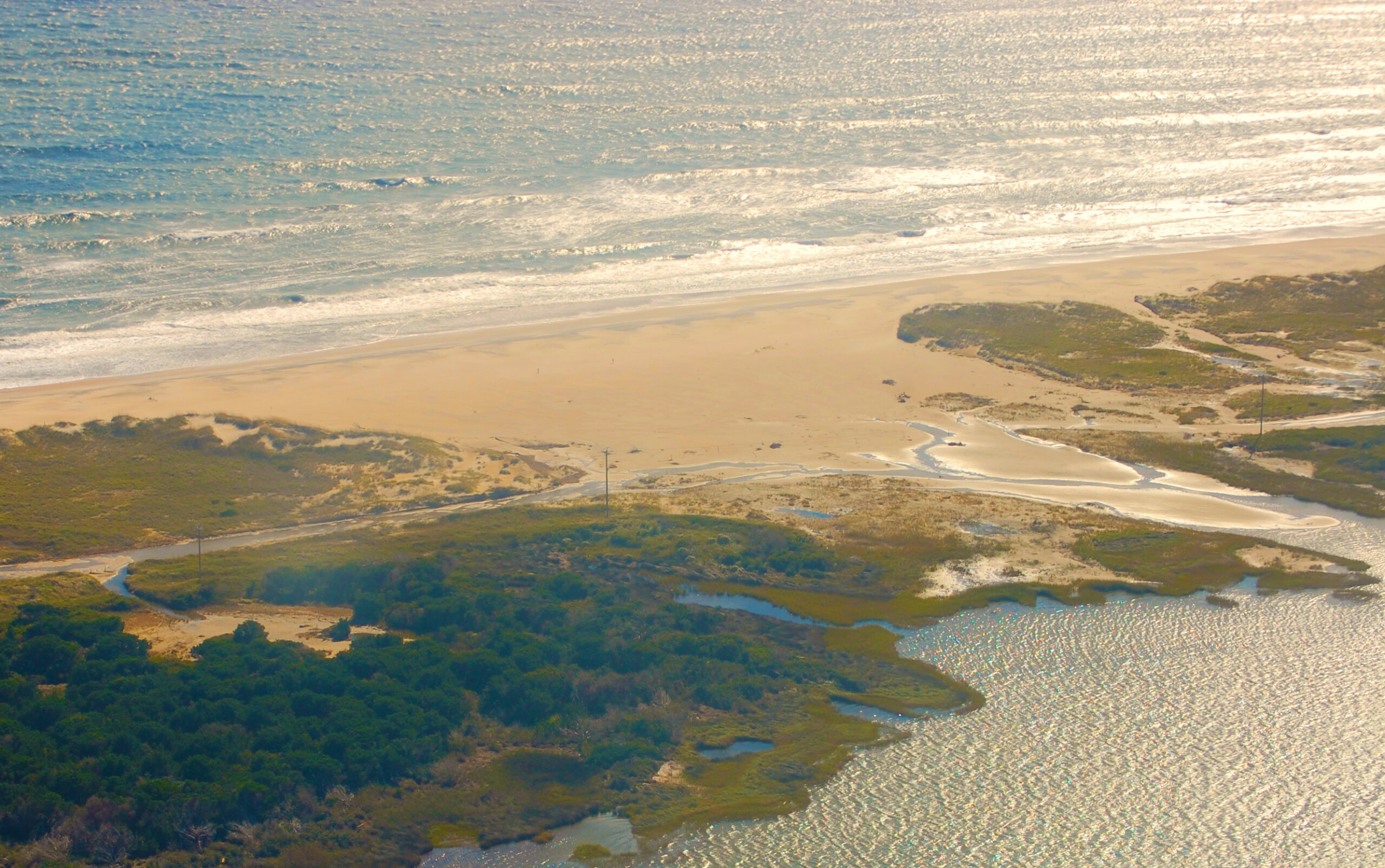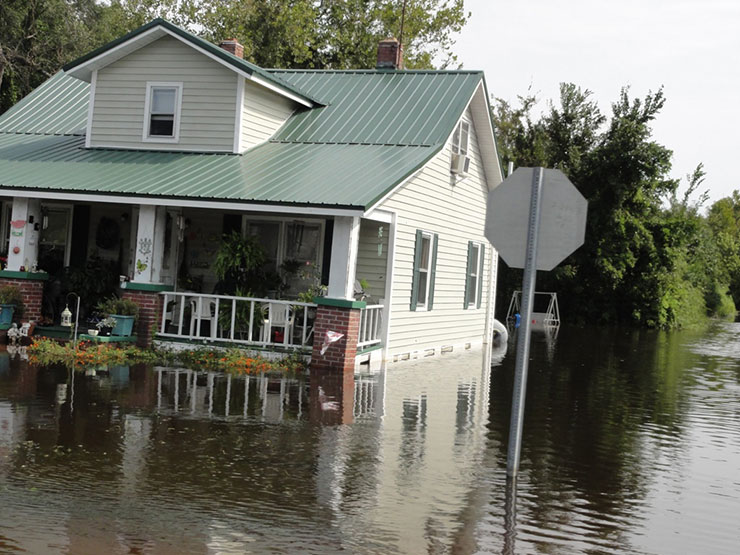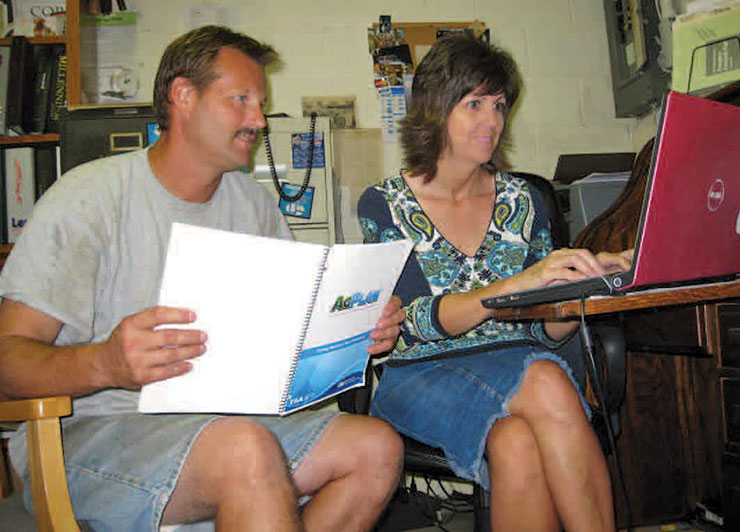Sand…we play in it, we stroll on it, we make castles out of it, we spread our beach towels on it. But what do we really know about it?
Webster’s New World College Dictionary defines sand as “loose, gritty particles of worn or disintegrated rock, varying in size from about 1/16 mm to 2 mm in diameter, usually deposited along the shores of bodies of water, in river beds, or in deserts.”
Most people use the term sand to refer to loose material on a beach, but sand is actually a grain size measurement used by geologists to describe sediments. The scale runs from smallest to largest, from clay to boulders, with silt, sand, gravel, pebbles and cobbles in between. And to make matters more complex, sand varies from very fine to very coarse.
So, where does sand come from?
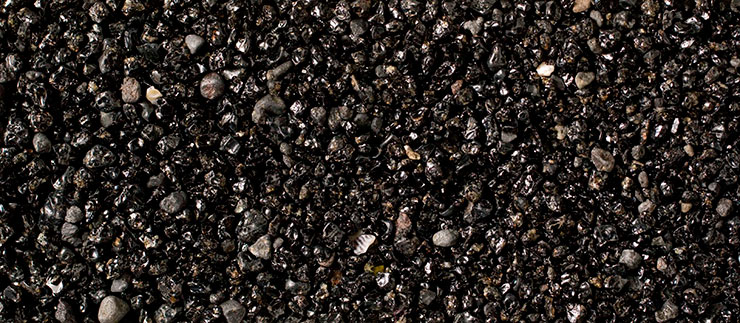
In some states, such as California, sand comes down rivers directly to the coast. In North Carolina, our rivers empty into our extensive sound and estuary system. Most sand on our beaches comes to us by longshore currents, movement of sand up and down the coast by wave action, and by beach-building waves that bring sand from offshore storage areas such as sandbars, ebb and flood tide deltas, and the capes. Beaches tend to build up during the gentle, low-energy waves of summer. Winter and its high-energy waves take the sand away and store it in offshore sandbars.
Mineral and volcanic sands are terrigenous, meaning that they come from the land. Mineral sands start as mountains and boulders and are gradually broken into smaller and smaller particles by weathering and erosion. Think of rocks, being alternately heated and cooled through the seasons, rolling and tumbling around in mountain streams and rivers, being broken apart by the water’s movement.
The black sand beaches of some islands — such as Hawaii — are volcanic in origin. Molten lava from deep inside the earth becomes lava rocks after cooling. These rocks break down into sand over time through the physical processes of weathering.
Some sand is biogenic — meaning that it comes from living things, such as shells and coral. The energy from water breaks shells down into tiny pieces that eventually wash onto beaches. Parrotfish in the tropics use their teeth to scrape off and grind down bits of coral reefs; the undigested particles pass through the fishes’ digestive systems and end up as sand on tropical beaches.
Around the world, beach sands can be comprised of minerals, bits of shell or coral, volcanic material, glass, or any combination of these materials. Some beaches are covered with pebbles and cobbles instead of sand. Check out the pebbly beaches of New England.
Quartz (silicon dioxide), feldspar and shells are the most common materials on North Carolina beaches. You also can find sand-sized pieces of other minerals, including magnetite and garnet. Patches of pea gravel are common along Outer Banks beaches. These areas of pea-sized quartz, with a few shell fragments mixed in, are locations of old river channels. As the barrier islands migrate, these sections of old river bottom are exposed and moved around.
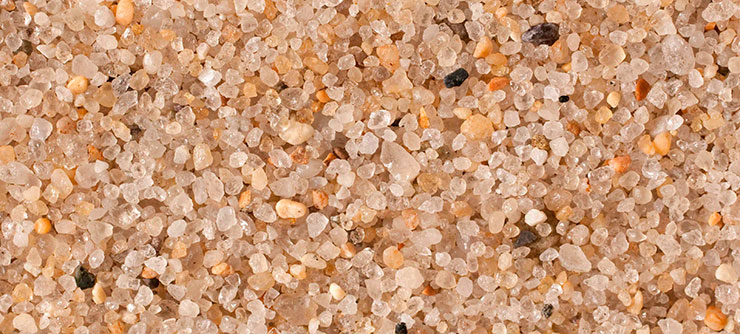
Small areas of shell hash, where shards of seashells predominate, can be found up and down the North Carolina coast. These biogenic features are created by a combination of waves and currents. Mollusk shells take years to get rounded and polished by the waves and sand.
Examine the beauty of beach sand with a magnifying glass. The shape, size and color of the sand grains can tell many stories.
Shape indicates the age of sand grains. Different materials break down at different rates. For example, quartz is very sturdy and takes longer to become sand than the calcium carbonate material of mollusk shells. Younger sand has sharp and angled edges; it needs time and wave action to become rounded. Smooth and well-rounded sand particles are evidence that they have been rolled around for some time.
Even though all sand grains are small, some are smaller than others. Wave action is the story told with grain size. Small waves move small sand grains around; large waves move large grains. In addition, Aeolian transport, or sand movement driven by winds, shifts the sand on the beach, shaping and reshaping, covering and uncovering.
Color offers evidence for source materials. Sand particles that are clear, tan, gray or brown might be quartz or feldspar. Black or gray particles could be ilmenite (titanium oxide) or magnetite (iron oxide). Garnets are red. Mica is silvery black or gray. And shells are purple, white, black or brown.
Patches of black sand can sometimes be seen, especially after storms. On North Carolina beaches, these dark areas are not volcanic in origin, but are swatches of heavy mineral sands that high-energy waves and strong winds uncover and move together in layers. Pick up some “heavies” in one hand, and some regular quartz beach sand in another. The weight difference is obvious.
The chorus from the song “Mountain in my Hand” on the Only One Ocean CD by the Banana Slug String Band explains it best.
I’ve got a mountain in my hand from the rain-washed land,
Down by the sea now is where I stand,
With this mountain in my hand trying to understand,
Oh, oh, wonderful sand.
The next time you go to the beach, whether at the ocean or beside a river, take a closer look at the sand and think about the stories those grains can tell.
Learn More
To learn more about sand and sand collectors, or arenophiles, check out the resources below.
Listen
Enjoy these albums by the Banana Slug String Band: Only One Ocean and Slugs at Sea.
Visit
The Dune Book: www.ncseagrant.org/s/dunebook
A collection of sand photos: www.sandrific.com
The International Sand Collectors Society: www.sandcollectors.org/ISCSHomeIndexx.html
The Coastal Imaging Lab at Oregon State University: cil-www.coas.oregonstate.edu
Read
Books for Children
Griggs, Gary, Catherine Halversen, and Craig Strang. 2007. Gary’s Sand Journal. Nashua, N.H.: Delta Education.
Points, Larry and Andrea Jauck. 1997. Ribbons of Sand: Exploring Atlantic Beaches. Mariposa, Calif.: Sierra Press.
Strang, Craig. 2007. Shoreline Scientist. Nashua, N.H.: Delta Education.
Books for Adults
Greenberg, Gary. 2008. A Grain of Sand: Nature’s Secret Wonder. Minneapolis, Minn.: Voyageur Press.
Neal, William J., Orrin H. Pilkey, and Joseph T. Kelley. 2007. Atlantic Coast Beaches: A guide to ripples, dunes, and other natural features of the seashore. Missoula, Mont.: Mountain Press Publishing Company.
Pilkey, Orrin H., Tracy Monegan Rice, and William J. Neal. 2004. How to Read a North Carolina Beach: Bubble holes, barking sands, and rippled runnels. Chapel Hill, N.C.: University of North Carolina Press.
Witherington, Blair, and Dawn Witherington. 2011. Living Beaches of Georgia and the Carolinas: A Beachcomber’s Guide. Sarasota, Fla.: Pineapple Press.
This article was published in the Holiday 2011 issue of Coastwatch.
For contact information and reprint requests, visit ncseagrant.ncsu.edu/coastwatch/contact/.
- Categories:
